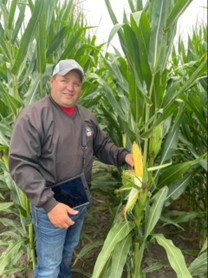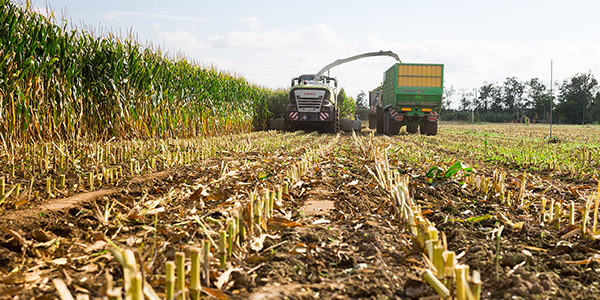AGRONOMICSUPPORT
YOU CAN TAKETO THE FIELD
Set Yourself up for a Successful Corn Silage Harvest
Now is a great time to review some of the best practices for an efficient corn silage harvest that delivers the best return on your investment. “Making that happen can be a balancing act,” says Alan Bass, an LG Seeds agronomist in Wisconsin.
Monitor crop maturity to get the timing right

“Farmers should chop silage when whole plant moisture falls between 60% and 70%,” Bass generalizes, adding the percentage varies depending on a farmer’s method of storing corn silage. “With a bunker silo, you get a better, tighter pack that keeps oxygen out of the silage if the moisture is closer to 70%,” he explains. “For upright, sealed storage structures, you want silage a bit drier – in the 55% to 60% range.”
Crop stage is another major determinant. Farmers using a kernel processor should target two-thirds milk line for chopping, according to Bass, who notes such processing dramatically improves feed utilization. “Those without a kernel processor should chop when the kernel is around the three-quarters milk line, so the kernel is a bit softer.”
Strike the right balance between tonnage and quality
Chopping height can range from 7 inches to 20 inches, but Bass notes the lower the cut, the less digestible the silage. “If you raise the cutter bar to 15 to 19 inches, you’ll get a higher-quality silage that’s more digestible. But the downfall of that is your tonnage will be hit. It’s a balancing act for the farmer,” Bass says, encouraging farmers to lean on their nutritionists.
“Increasing the height to improve silage quality is usually not profitable, since the improvement in quality rarely offsets the yield loss,” the University of Wisconsin says, citing a Wisconsin study that showed increasing the harvest height from 6 to 18 inches reduced yields up to 0.6 tons per acre while reducing the neutral detergent fiber (NDF), a predictor of voluntary intake, from 59.9% to 59.4%.
But the university added that another study showed high nitrate concentration in the lower part of the stalk may justify increasing the harvest height.
Added considerations for farmers in drought areas
High nitrate levels are of particular concern for farmers in areas struggling with drought. Drought-stressed crops typically have higher-than-usual nitrate levels in the lower part of the plant. Nitrates ingested by cattle can be toxic. “Therefore, we like to keep that cutter bar higher in drought areas to reduce nitrates in that silage,” Bass says.
Waiting 10 to 14 days after a considerable rain to chop silage can give drought-stressed corn plants a chance to dilute any influx in nitrates, Bass adds. He also says keeping silage wetter (around 70%) for ensiling can help. Find more tips for dealing with high nitrates in corn silage.
Determine what to chop
When deciding what fields to chop, some farmers pick the worst looking ones. That’s not a great strategy. “The best corn in the field usually makes the best silage, whereas stressed acres are more susceptible to disease, aflatoxins or molds,” Bass explains.
He also notes that while hybrids bred for silage might offer good quality, they tend to lack in tonnage. LG Seeds offers silage-proven products that don’t sacrifice tonnage and offer the flexibility of being harvested for grain.
A stringent silage qualification program differentiates LG Seeds’ silage-proven hybrids, Bass explains. “We test the whole plant, the starch, the energy, the protein and the digestibility of products to determine if they are silage-proven.”
Bass says LG59C72 and LG52C42 are two dual-purpose hybrids that have been solid performers and look great again this year.
Line up help and prep equipment and bunkers
“At harvest, the faster you can fill and pack that silage bunker to eliminate oxygen, the better,” Bass says. “Speed is critical when it comes to chopping corn silage, but it also needs to be done right,” he says.
Good help is a critical component. “Get the help lined up to get that silage chopped, packed and covered in a timely fashion,” Bass advises, adding that lining up workers is often the biggest challenge when it comes to chopping silage.
A good manager is a critical component to keeping things running smoothly. “Operations that do a good job getting silage chopped and stored efficiently have really good managers,” according to Bass.
Other steps that can help pave the way for efficient silage harvest include cleaning out bunkers and preparing equipment. “Make sure you’ve gone through the checklist for readying the chopper,” Bass says.
Take notes for future success
Record-keeping during harvest can pave the way for future success. “Collect tonnage per acre, and after it’s ensiled, test the silage to assess key benchmarks for tonnage, energy, digestibility, etc.,” Bass recommends. “Then you can evaluate what hybrids might meet your ration qualifications for the year ahead.”
Bass encourages farmers to turn to their local LG Seeds agronomists or visit LGSeeds.com for corn silage questions.





